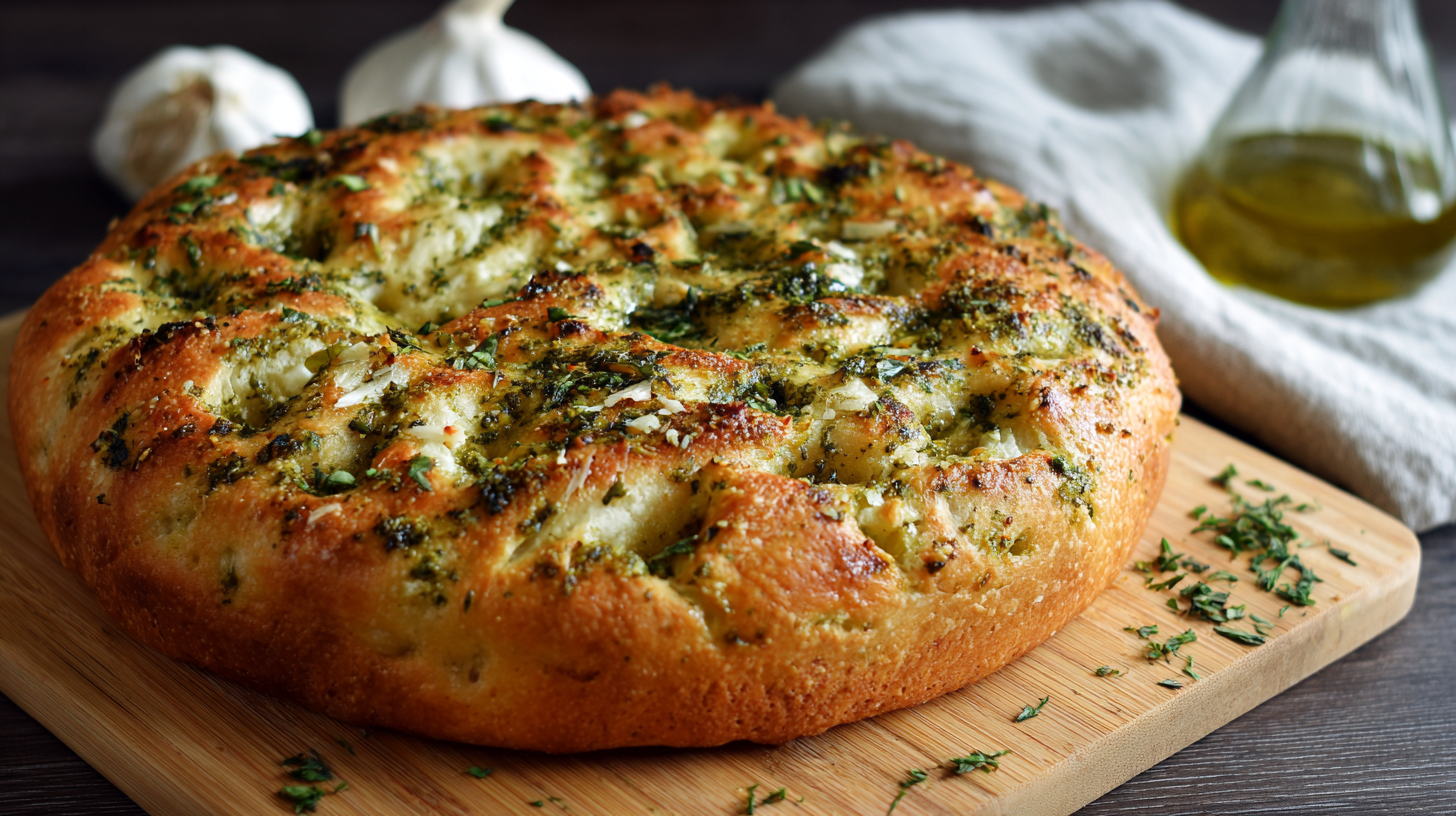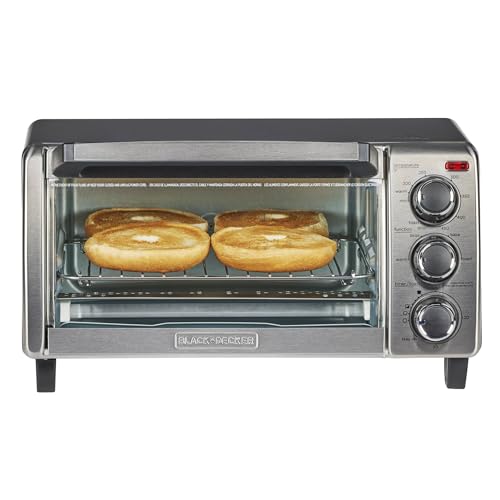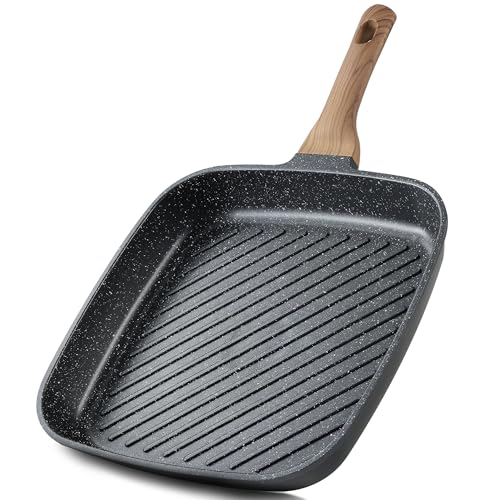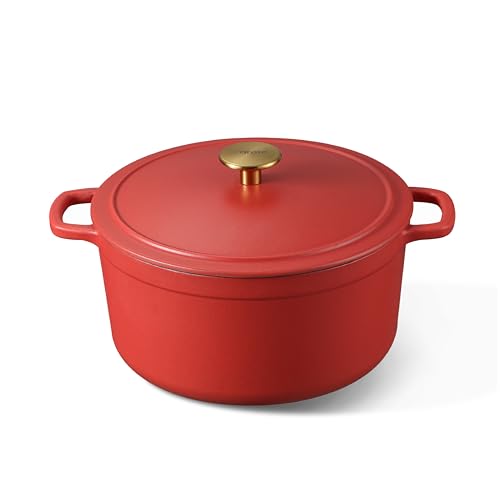The Perfect Easy Focaccia With Pesto Recipe
Creating this stunning homemade focaccia with pesto requires minimal effort but delivers maximum flavor. Your kitchen will fill with the irresistible aroma of freshly baked bread as this Italian classic comes together. Follow these straightforward steps to achieve a perfectly fluffy yet crisp focaccia topped with vibrant homemade pesto.
Ingredients
For the focaccia dough:
- 4 cups all-purpose flour
- 2 teaspoons instant yeast
- 2 teaspoons salt
- 2 cups warm water
- 1/4 cup extra virgin olive oil, plus more for drizzling
- 1 tablespoon coarse sea salt for topping
For the homemade pesto:
- 2 cups fresh basil leaves, packed
- 1/2 cup freshly grated Parmesan cheese
- 1/3 cup pine nuts (toasted optional)
- 3 garlic cloves
- 1/2 cup extra virgin olive oil
- Salt and pepper to taste
Making the Focaccia Dough
Begin by combining the flour, instant yeast and salt in a large mixing bowl. Pour in the warm water and 1/4 cup olive oil, then mix until a sticky dough forms. No kneading is necessary for this recipe—simply stir until all ingredients are incorporated.
Cover the bowl with plastic wrap or a damp kitchen towel and let the dough rise at room temperature for 2-3 hours. The dough should double in size and develop a bubbly texture on top.
Once risen, pour about 2 tablespoons of olive oil into a 9×13 inch baking pan. Transfer the dough to the oiled pan and gently stretch it to fill the corners. Don’t worry if it doesn’t reach perfectly—the dough will continue to spread as it rises again.
Allow the dough to rise for another 30-60 minutes while you prepare the pesto.
Preparing the Pesto
Add basil leaves, Parmesan cheese, pine nuts and garlic to a food processor. Pulse several times until coarsely chopped. With the processor running, slowly drizzle in the olive oil until you achieve a smooth consistency.
Season your pesto with salt and pepper to taste. The fresh pesto can be prepared up to 2 days ahead and stored in an airtight container in the refrigerator.
Baking the Focaccia
Preheat your oven to 425°F (220°C). When the dough has finished its second rise, use your fingertips to create dimples across the entire surface. These indentations will catch pools of olive oil and create the characteristic focaccia texture.
Drizzle another 2 tablespoons of olive oil over the dimpled dough, then sprinkle with coarse sea salt. Bake for 20-25 minutes until the top is golden brown and the bottom is crisp.
Adding the Pesto
Remove the focaccia from the oven and let it cool slightly before adding the pesto. You can either spread a generous layer across the entire bread or dollop spoonfuls in a pattern. For an extra touch, consider adding some halved cherry tomatoes or additional pine nuts on top.
Return the focaccia to the oven for 2-3 minutes to warm the pesto slightly. This quick additional bake helps the flavors meld together without cooking the pesto, preserving its vibrant color and fresh taste.
Allow the finished focaccia with pesto to cool for 5-10 minutes before slicing. This resting time lets the bread structure set properly and makes for cleaner slices.
Why You’ll Love This Homemade Focaccia
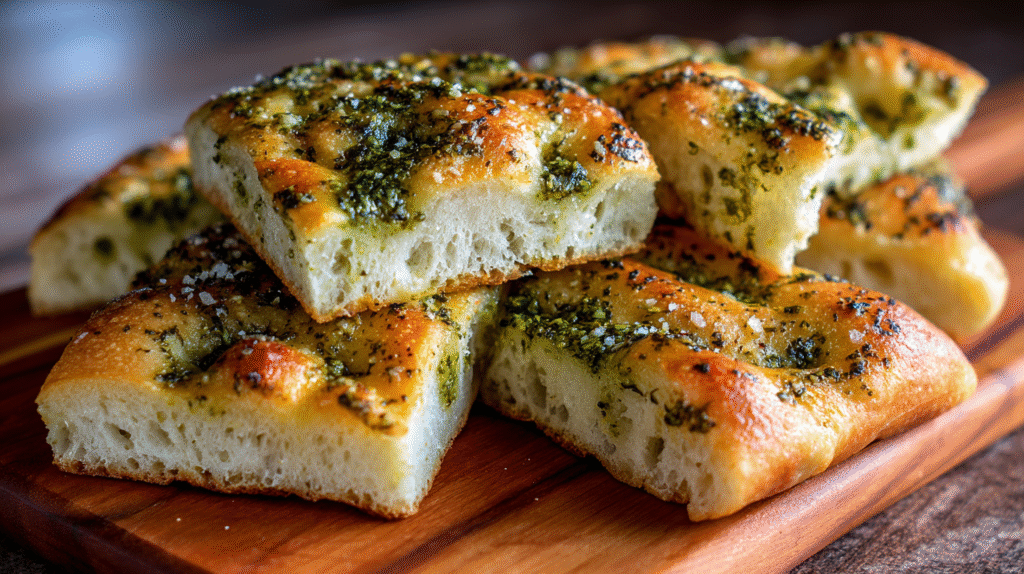
This focaccia recipe offers incredible flavor with minimal effort, making it perfect for both novice bakers and experienced bread enthusiasts. The pillowy soft interior contrasts beautifully with the crispy, olive oil-infused exterior that’s become the hallmark of authentic Italian focaccia. Your kitchen will fill with an irresistible aroma as this bread bakes to golden perfection.
Making bread at home often seems intimidating, but this recipe eliminates the need for kneading or special equipment. The simple no-knead technique allows the dough to develop gluten naturally during its rise time, resulting in those characteristic air pockets that give focaccia its distinctive texture.
Fresh homemade pesto elevates this bread from simply delicious to absolutely extraordinary. The vibrant basil pesto adds a burst of color and flavor that perfectly complements the sea salt and olive oil in the dough. You can easily customize this recipe by adding cherry tomatoes, extra pine nuts, or even a sprinkle of parmesan cheese before serving.
Versatility makes this focaccia a true kitchen hero – serve it as an appetizer with olive oil for dipping, use it for gourmet sandwiches, or pair it with your favorite Italian dishes. The recipe yields a generous portion that’s perfect for sharing at dinner parties or family meals, though leftovers reheat beautifully if you’re lucky enough to have any.
Ingredients For The Focaccia Dough
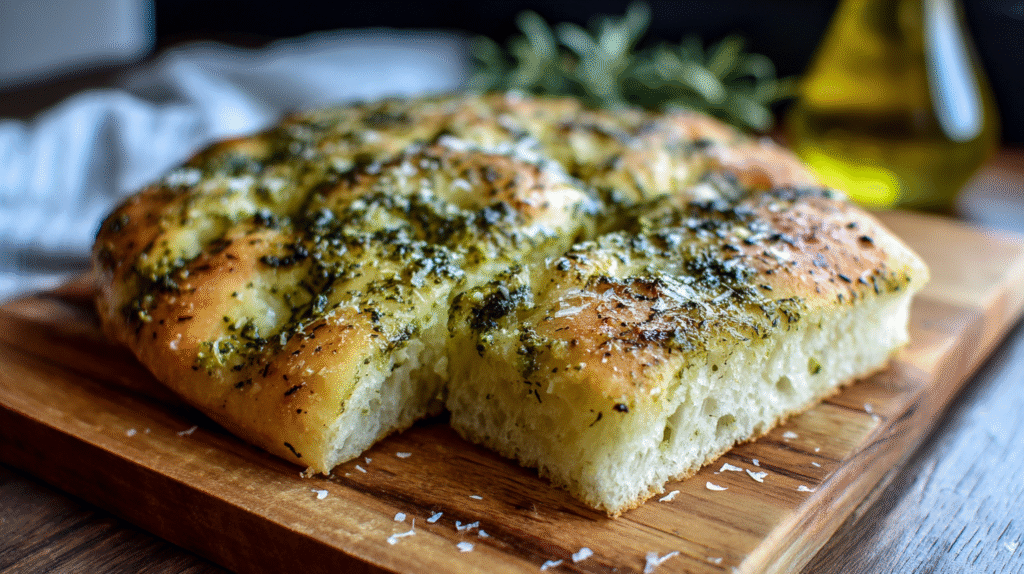
For this easy homemade focaccia, you’ll need just a handful of basic ingredients that combine to create that signature pillowy texture with a crisp exterior. The beauty of focaccia dough lies in its simplicity, allowing the olive oil and salt to shine through.
- 4 cups (500g) all-purpose flour
- 2 teaspoons instant yeast
- 2 teaspoons salt
- 1 3/4 cups (420ml) warm water (about 110°F/43°C)
- 1/4 cup (60ml) extra virgin olive oil, plus more for the pan
- 1 tablespoon coarse sea salt for topping
- 2 tablespoons fresh rosemary (optional)
The quality of your olive oil matters significantly in this recipe as it contributes substantially to the flavor profile. Look for a good quality extra virgin olive oil that will infuse the dough with rich, authentic Mediterranean flavor. Your water temperature should be warm but not hot to properly activate the yeast without killing it.
All-purpose flour works perfectly for this recipe, creating just the right amount of gluten development for that characteristic focaccia texture. The instant yeast eliminates the need for proofing, making this recipe even more accessible for beginners.
The coarse sea salt sprinkled on top before baking not only enhances flavor but also provides that delightful textural contrast with each bite. Fresh rosemary is optional but highly recommended for its aromatic contribution to the classic focaccia experience.
Ingredients For The Pesto Topping
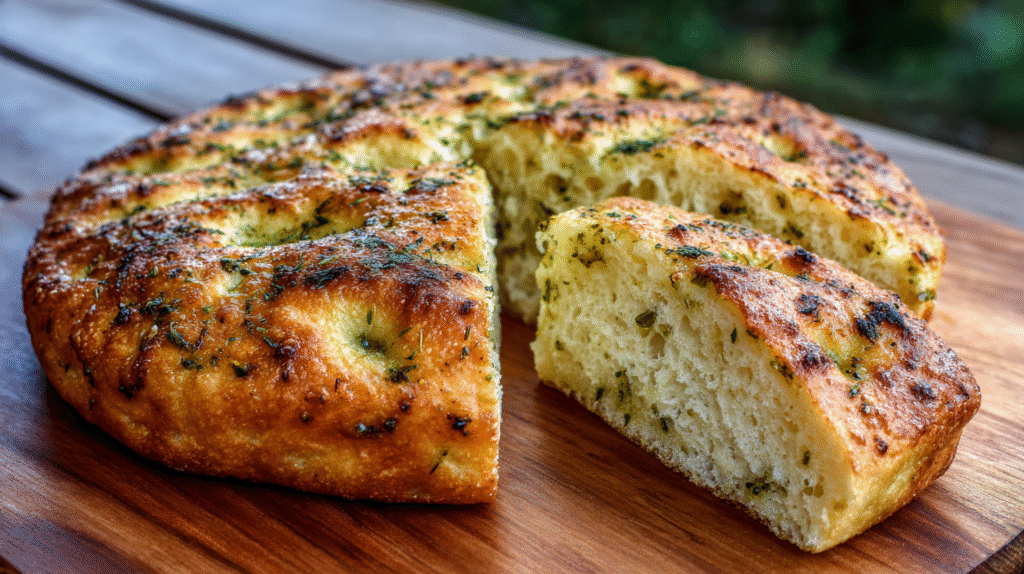
For a vibrant homemade pesto that perfectly complements your focaccia, gather these fresh ingredients:
- 2 cups fresh basil leaves, packed
- ½ cup freshly grated Parmesan cheese
- ⅓ cup pine nuts
- 3 cloves garlic, peeled
- ½ cup extra virgin olive oil
- ¼ teaspoon salt
- ⅛ teaspoon freshly ground black pepper
- Optional: 2 tablespoons fresh lemon juice for brightness
Quality matters tremendously when creating pesto, so seek out the freshest basil you can find with vibrant green leaves and no wilting. Traditional Parmigiano-Reggiano provides the most authentic flavor, though Pecorino Romano offers a sharper alternative if preferred. Toasting your pine nuts briefly in a dry skillet enhances their nutty flavor profile and adds depth to your finished pesto. Fresh garlic cloves deliver the best punch, avoiding the bitter notes sometimes found in pre-minced options. Select a high-quality extra virgin olive oil since this ingredient significantly impacts the final taste of your pesto topping.
Your homemade pesto will maintain its vibrant green color and fresh flavor when stored properly in an airtight container with a thin layer of olive oil on top. This versatile sauce works beautifully as a focaccia topping but also doubles as a pasta sauce or sandwich spread with any leftovers.
Equipment You’ll Need
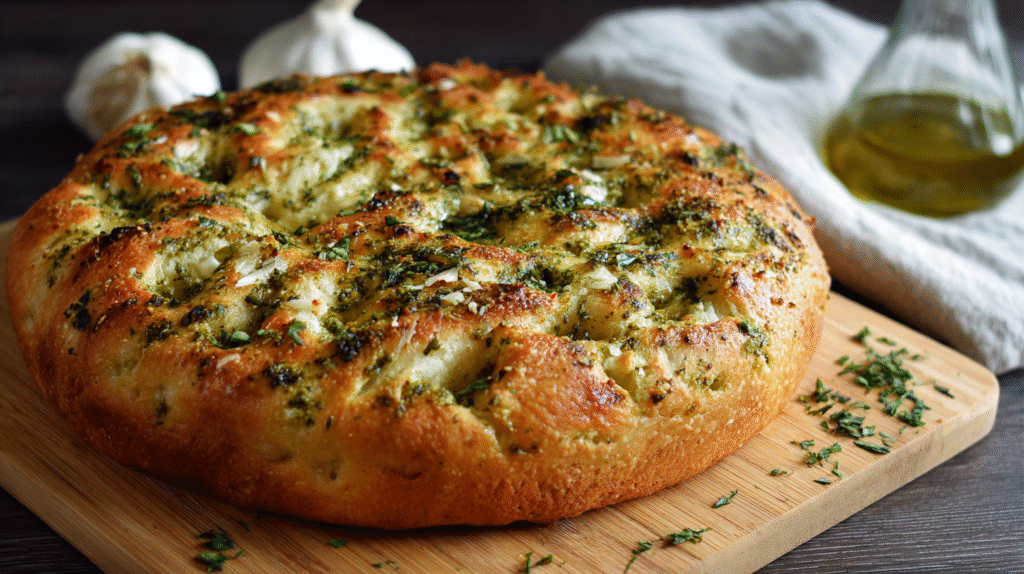
Creating this easy focaccia with pesto recipe requires minimal equipment that most home kitchens already have. Gather these tools before starting to ensure a smooth baking process:
- Large mixing bowl – For combining your dough ingredients and allowing proper rising
- Measuring cups and spoons – For accurate ingredient measurements
- 9×13-inch baking pan – Provides the perfect depth and size for traditional focaccia
- Plastic wrap or clean kitchen towel – To cover the dough during rising periods
- Food processor or blender – Essential for creating smooth homemade pesto
- Spatula – For scraping down sides of the food processor and spreading pesto
- Pastry brush – Helpful for evenly distributing olive oil on the pan and dough surface
- Fingertips – Yes, your fingers are a tool! They create the signature dimples in focaccia
- Cooling rack – Allows air circulation under the bread for proper cooling
The beauty of this recipe lies in its simplicity—no stand mixer or specialized bread-making equipment required. Your hands do most of the work, creating that authentic rustic texture that makes focaccia so special. A digital kitchen scale can be helpful for measuring flour precisely but isn’t absolutely necessary if you’re comfortable with cup measurements.
How To Make Focaccia With Pesto
Creating this rustic Italian bread with vibrant pesto is easier than you might think. Follow these straightforward steps to achieve bakery-quality focaccia in your home kitchen.
Preparing The Dough
Start by combining 4 cups of all-purpose flour, 2 teaspoons of instant yeast, and 2 teaspoons of salt in a large mixing bowl. Whisk these dry ingredients together to ensure even distribution. Pour in 1¾ cups of warm water (around 110°F) and ¼ cup of extra virgin olive oil. Mix with a wooden spoon or spatula until no dry flour remains and a sticky dough forms. Don’t worry about kneading—this is a no-knead dough that develops gluten during the rising process. The dough will appear rather wet and shaggy at this stage, which is exactly what you want for authentic focaccia.
First Rise
Drizzle 1-2 tablespoons of olive oil over your dough and turn it in the bowl to coat all sides. Cover the bowl with plastic wrap or a damp kitchen towel to prevent the surface from drying out. Place the covered bowl in a warm draft-free spot for 60-90 minutes. The dough should double in size and develop a bubbly surface. You’ll know it’s ready when it looks puffy and has visible air bubbles throughout. This slow fermentation is key to developing the focaccia’s characteristic flavor.
Shaping The Focaccia
Pour 2-3 tablespoons of olive oil into a 9×13-inch baking pan, spreading it evenly across the bottom and sides. Transfer your risen dough to the oiled pan by gently scraping it from the bowl with a spatula. Handle the dough minimally to avoid deflating the air bubbles that have formed during rising. Gently stretch and press the dough toward the edges of the pan without tearing it. The dough might not reach all corners immediately—that’s perfectly fine as it will continue to relax and spread during the second rise.
Second Rise
Allow the dough to rest uncovered in the pan for 20-30 minutes. During this time, preheat your oven to 425°F and position a rack in the middle. After the brief rest, drizzle another tablespoon of olive oil over the surface of the dough. Create the signature focaccia dimples by pressing your fingertips deeply into the dough at 1-inch intervals, going almost to the bottom of the pan but not puncturing the dough completely. Sprinkle the top with coarse sea salt and fresh rosemary if desired. These dimples will create the classic focaccia texture and catch pools of olive oil and toppings.
Adding The Pesto Topping
For traditional focaccia, you’ll bake the bread first before adding the pesto. Bake the dimpled dough for about 20 minutes until it turns light golden. Remove from the oven and immediately spread 1/2 cup of your prepared pesto evenly over the hot surface. The residual heat will release the aromatic oils in the pesto without cooking it completely. For a baked pesto version, spread half the pesto over the dimpled dough before its initial baking, then add the remaining fresh pesto after baking. This dual-application method creates layers of flavor as some pesto bakes into the bread while the fresh pesto on top maintains its vibrant color and taste.
Baking To Perfection
Return the pesto-topped focaccia to the oven for an additional 5-7 minutes. The bread is done when the edges are golden brown and crispy, and the center feels firm when gently pressed. The bottom should be crisp and golden when you lift an edge to peek underneath. Remove the finished focaccia from the oven and brush the edges with a little more olive oil for extra flavor and sheen. Allow the bread to cool in the pan for 5 minutes, then transfer it to a wire rack to cool for another 10 minutes before slicing. This cooling period allows the crumb structure to set properly, ensuring the perfect texture when you bite into your homemade creation.
Tips For The Best Focaccia
Creating the perfect focaccia requires attention to detail and a few insider techniques. Follow these professional tips to elevate your homemade focaccia from good to exceptional:
Use High-Quality Ingredients
Always select premium extra virgin olive oil for authentic Italian flavor. The oil infuses the entire dough and creates that distinctive focaccia taste. Freshly milled flour produces better results than flour that has been sitting in your pantry for months. Choose coarse sea salt for topping as it provides both visual appeal and delightful crunchy texture with each bite.
Perfect Your Hydration
Focaccia dough should be significantly wetter than standard bread dough. Aim for approximately 75-80% hydration ratio (water to flour by weight) to achieve those characteristic large air pockets. Don’t worry if the dough seems too sticky at first—this moisture content is essential for authentic texture. Resist the urge to add extra flour even if the dough appears wet.
Master the Dimpling Technique
Create proper dimples by pressing your fingertips straight down into the dough rather than poking at an angle. These indentations should nearly reach the bottom of the pan without tearing the dough. Drizzle olive oil generously over the dimpled surface before baking—the oil will pool in these depressions creating flavor pockets throughout the bread.
Control Your Temperature
Room temperature matters significantly for proper fermentation. Ideal dough rising happens between 75-78°F (24-26°C). During colder months, create a warm environment by placing your dough near a heat source or in an oven with just the light turned on. For the best flavor development, consider using cold fermentation by refrigerating the dough overnight after the first rise.
Perfect Your Baking Method
Preheat your oven thoroughly with a baking stone or steel if available for maximum heat retention. Bake at a high temperature (425-450°F) to achieve that golden crispy exterior while maintaining a soft interior. Position your rack in the lower third of the oven for optimal heat distribution. For extra crispiness, spray the oven walls with water at the beginning of baking to create steam.
Don’t Rush the Process
Allow adequate time for each rise—rushing produces dense bread lacking those signature air pockets. The first rise typically requires 1-2 hours while the second rise in the pan needs at least 30-45 minutes. Watch for visual cues rather than strictly following time guidelines; properly risen dough should be puffy and nearly doubled in size.
Make-Ahead And Storage Instructions
Preparing Focaccia Dough in Advance
You can prepare your focaccia dough up to 24 hours before baking for even more developed flavor. After mixing the dough, place it in an oiled bowl covered with plastic wrap and refrigerate overnight. The cold temperature slows down fermentation while improving flavor complexity. Remove the dough from the refrigerator about 1-2 hours before you plan to shape it, allowing it to come to room temperature before proceeding with the dimpling and baking steps.
Making Pesto Ahead of Time
Pesto actually benefits from being made in advance as the flavors meld together beautifully. Store your freshly made pesto in an airtight container with a thin layer of olive oil on top to prevent oxidation. Keep it refrigerated for up to 5 days before using it on your focaccia. This time-saving step allows you to focus solely on the bread when you’re ready to bake.
Storing Baked Focaccia
Freshly baked focaccia with pesto stays delicious at room temperature for up to 2 days when wrapped in a clean kitchen towel or parchment paper. For longer storage, place completely cooled focaccia in an airtight container and refrigerate for up to 5 days. Avoid plastic wrap directly on the bread as it can make the crust soggy.
Freezing Options
Your focaccia freezes exceptionally well both before and after baking. For pre-baked storage, freeze shaped dough (before the second rise) on a baking sheet until solid, then wrap tightly in plastic wrap and aluminum foil. Defrost in the refrigerator overnight, allow to come to room temperature, then proceed with the second rise and baking instructions.
For baked focaccia, cool completely, slice into portions, and wrap each piece tightly in plastic wrap followed by foil. Freeze for up to 3 months. Individual slices can be defrosted at room temperature for 1-2 hours or briefly microwaved.
Reheating Instructions
Revive your focaccia’s crispy exterior by reheating in a 350°F oven for 5-7 minutes. For slices, 3-4 minutes usually suffices. Microwaving works in a pinch (30 seconds per slice), though the texture becomes softer rather than crisp. Wrapping the focaccia in foil while reheating helps maintain moisture but sacrifices some crispness.
Refreshing Day-Old Focaccia
Transform day-old focaccia by lightly spritzing it with water and reheating in a 350°F oven for 5-7 minutes. This simple technique rehydrates the bread while revitalizing the crust. Alternatively, turn leftover focaccia into croutons or breadcrumbs for soups and salads by cutting into cubes and toasting until crisp.
Serving Suggestions
Transform your easy focaccia with pesto into a memorable dining experience with these versatile serving ideas. This Italian bread sensation pairs beautifully with many accompaniments making it suitable for any occasion from casual family dinners to elegant gatherings.
Serve your freshly baked focaccia as an appetizer alongside a selection of Italian antipasti. Arrange a platter with prosciutto marinated artichokes olives and fresh mozzarella for an impressive starter that guests will love. The combination of these savory items with your herb-infused bread creates a perfect balance of flavors and textures.
Turn your focaccia into the star of a gourmet sandwich by slicing it horizontally and filling it with layers of Italian meats cheeses and vegetables. Try combinations like salami provolone and roasted red peppers or fresh mozzarella tomato and basil for a caprese-inspired option. The sturdy yet tender texture of the bread holds up well to hearty fillings without becoming soggy.
Pair this pesto-topped bread with soups and stews for a complete meal. The focaccia works wonderfully for sopping up the last bits of minestrone ribollita or pasta e fagioli. Its pesto topping adds an extra dimension of flavor that complements these traditional Italian soups perfectly.
Create a pasta night spread with your focaccia as the perfect side dish. The herbaceous notes from the pesto bread enhance classic pasta dishes like spaghetti bolognese fettuccine alfredo or linguine with clams. Tear off pieces to enjoy between bites of pasta or use them to clean your plate of delicious sauce.
Serve your focaccia alongside a fresh green salad for a light yet satisfying lunch. The richness of the olive oil-infused bread balances the crispness of salad greens and vinaigrette. Add some grilled chicken or roasted vegetables to make it more substantial if desired.
Present your pesto focaccia as part of a wine and cheese board for an elevated entertaining option. Select soft and semi-hard Italian cheeses like taleggio pecorino or gorgonzola to complement the bread. A medium-bodied red wine such as Chianti or Montepulciano d’Abruzzo pairs exceptionally well with these flavors.
Breakfast becomes special when you toast slices of leftover focaccia and top them with ricotta honey and fresh fruit. The slight saltiness of the bread creates an interesting contrast with the sweet toppings making for a delightful morning treat or brunch offering.
Transform your focaccia into crostini by cutting it into small pieces toasting until crisp and topping with various ingredients. Try combinations like whipped ricotta with honey roasted cherry tomatoes with garlic or white bean spread with herbs. These make perfect bite-sized appetizers for parties or pre-dinner snacks.
Variations To Try
While the classic pesto focaccia is delicious on its own, you can easily customize this versatile bread to suit your taste preferences or dietary needs. These creative variations will help you expand your focaccia repertoire.
Different Herbs And Toppings
Transform your focaccia by experimenting with various herb and topping combinations:
- Sun-dried Tomato & Feta: Replace pesto with chopped sun-dried tomatoes and crumbled feta cheese for a Mediterranean twist
- Caramelized Onion & Rosemary: Spread caramelized onions over the dough before baking and sprinkle with fresh rosemary
- Olive & Herb: Press halved Kalamata or green olives into the dough along with fresh thyme and oregano
- Garlic & Herb Butter: Brush the hot focaccia with garlic butter and sprinkle with fresh herbs instead of using pesto
- Roasted Red Pepper & Goat Cheese: Top with strips of roasted red peppers and dollops of creamy goat cheese
- Wild Mushroom & Truffle Oil: Sauté wild mushrooms with garlic and spread over the focaccia, finishing with a drizzle of truffle oil
- Four Cheese: Sprinkle a combination of mozzarella, Parmesan, fontina, and asiago cheeses over the dough before baking
Try creating a seasonal focaccia by topping it with whatever produce is fresh and available. You might enjoy thinly sliced summer zucchini with lemon zest or roasted butternut squash with sage in autumn.
Gluten-Free Option
You can adapt this recipe for those with gluten sensitivities by making a few key adjustments:
- Replace the all-purpose flour with a high quality gluten-free flour blend designed for bread baking (look for one containing xanthan gum)
- Add 1 tablespoon of psyllium husk powder to improve the texture and elasticity of the dough
- Increase the water by about 2-3 tablespoons as gluten-free flours often require more hydration
- Expect a slightly different texture—gluten-free focaccia tends to be denser but can still be delicious
- Ensure your baking pan is well-oiled to prevent sticking
- Allow additional rising time as gluten-free dough typically rises more slowly
The pesto remains naturally gluten-free, but always check store-bought varieties for hidden gluten ingredients if you’re using premade pesto. Your gluten-free guests will appreciate the effort to include them in enjoying this Italian classic.
The History Of Focaccia
Focaccia’s origins date back to ancient Rome where early versions called “panis focacius” were baked on hearths by the Etruscans. The name itself derives from the Latin word “focus” meaning hearth or fireplace indicating its traditional cooking method on heated stones or in ashes.
Ancient Roman bakers developed this flatbread as a practical food that could be quickly prepared and easily transported. During the Middle Ages focaccia became a staple throughout the Italian peninsula with regional variations emerging in different cities and provinces.
Liguria in northwestern Italy particularly Genoa established itself as the spiritual home of modern focaccia. Genoese focaccia known as “fugàssa” in the local dialect became renowned for its distinctive texture and liberal use of olive oil. The coastal region’s abundance of olive groves contributed to the bread’s characteristic oily quality that distinguishes it from other flatbreads.
By the 16th century focaccia had evolved into various forms across Italy. The Tuscan version called “schiacciata” meaning “squashed” highlighted the bread’s flattened appearance while Puglia’s “focaccia barese” incorporated local ingredients like tomatoes olives and potatoes.
Traditional focaccia making involves a slow fermentation process that allows the dough to develop complex flavors. Bakers would typically prepare the dough in the evening let it rise overnight and bake it in the morning creating the signature airy texture with characteristic dimples that hold olive oil and toppings.
The addition of pesto to focaccia represents a natural pairing of two Ligurian culinary treasures. Pesto originating from Genoa in the 16th century combines the region’s abundant basil with pine nuts olive oil garlic and cheese creating a perfect complement to the region’s beloved bread.
Focaccia crossed the Atlantic with Italian immigrants in the late 19th and early 20th centuries becoming popular throughout North America. Today focaccia enjoys worldwide popularity with countless variations adapted to local tastes while still maintaining its rustic Italian character.
Modern artisanal bakeries have embraced focaccia for its versatility and relatively simple preparation compared to other bread styles. The bread’s resurgence in popularity during recent decades coincides with growing appreciation for authentic Mediterranean cuisine and traditional bread-making techniques.
Your homemade pesto focaccia connects you to this rich culinary heritage spanning millennia from ancient Roman hearths to your modern kitchen. This humble yet delicious bread continues to evolve while remaining true to its origins as a satisfying food that brings people together around the table.
Conclusion
This easy focaccia with pesto recipe brings the magic of Italian baking right to your kitchen with minimal effort and maximum flavor. You’ll love how the pillowy soft interior contrasts with the crispy crust while the vibrant homemade pesto adds a burst of fresh herbaceous goodness.
Whether you’re serving it as an appetizer paired with antipasti a side dish for your favorite pasta or transforming it into gourmet sandwiches this versatile bread fits any occasion. Don’t worry about leftovers – they reheat beautifully or can be repurposed into croutons or breadcrumbs.
With simple ingredients basic equipment and the foolproof techniques you’ve learned you’re ready to create this showstopping focaccia that will have everyone asking for your secret recipe!

